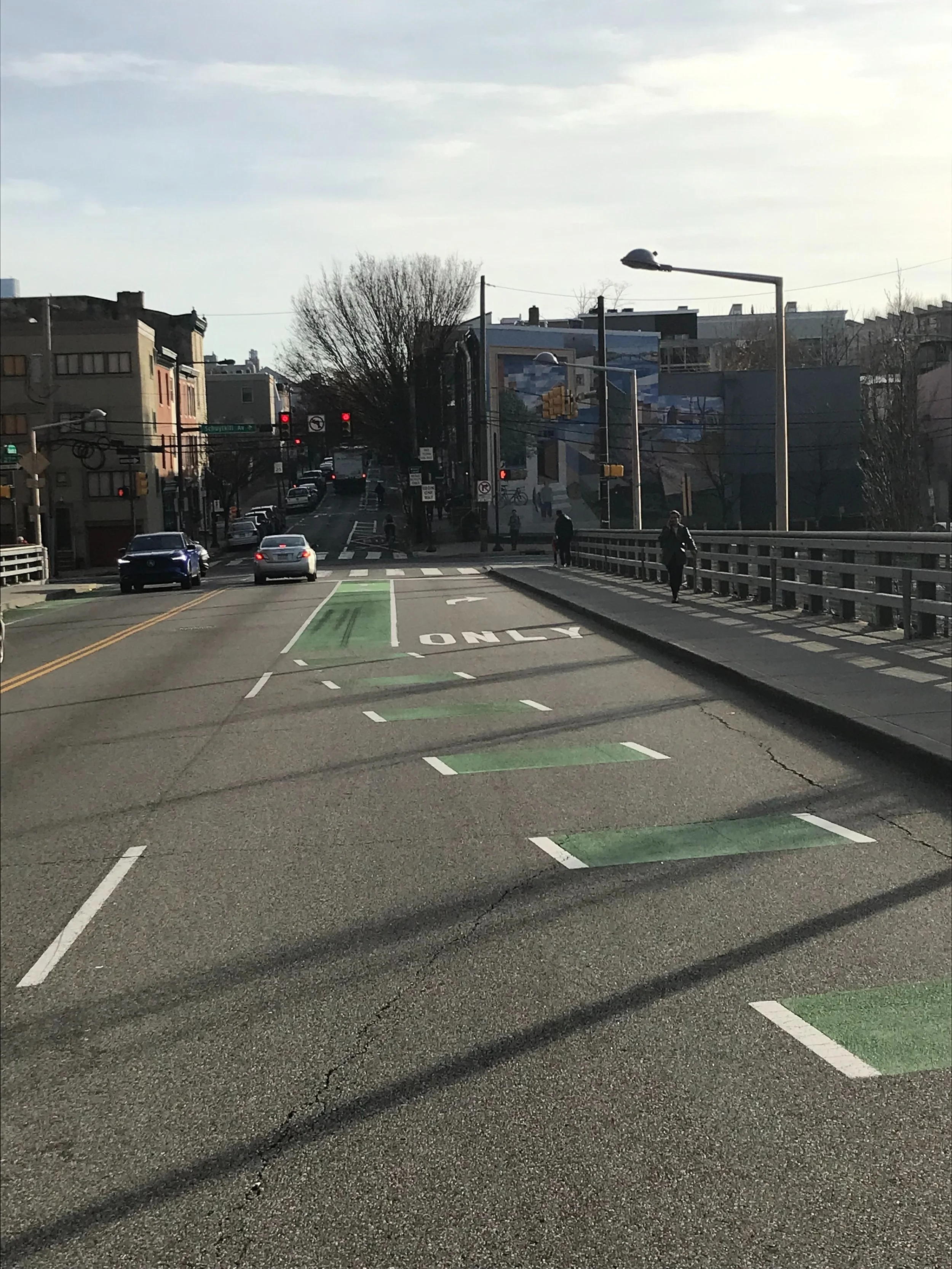RTKL Request: Bike Lane Edition
I recently submitted a Right to Know Law request to the Philadelphia Streets Department because I wanted to learn what person or organization designed the bike lanes on the South Street bridge. Like many people who live in West Philly and bike commute to Center City, I take the South Street bridge a lot, ten times a week going to and from my office. And I’m not the only one - according to the Bicycle Coalition of Philadelphia’s Bike Count, this bridge sees the most bikers of any bridge in the city, up to 470 per hour. The bike lanes on the bridge itself are fine. They’re not protected (there were flexiposts on the eastbound side pre-Covid but they slowly got destroyed or removed), but in my experience with so many people biking during morning/evening rush hours it feels safe enough. However, once you get across the bridge in either direction, the right hand turn lane for cars cuts through the bike lane. This is very dangerous!
In August, I submitted a RTKL request asking for:
311 Complaints about the intersection of 33rd and Spruce
A copy of the contract with the company that designs/makes bike lanes for the City
A copy of the policy or guidelines the Streets Department follows for designing bike lanes
The City sent me a response invoking its right to an additional 30 days to respond. After 30 days, I hadn’t heard back so I filed an appeal with the Office of Open Records, and I requested mediation.
Typically I don’t seek out mediation. In most RTK appeals, the agency has given me a response identifying what records they possess, and their reason for withholding some or all of them. From there, all I need to do is make my argument explaining why their cited exemption does not apply. In this case, however, I had no substantive response from the city, and it’s very difficult to make an argument about records you aren’t sure even exist. I requested mediation to have a direct conversation with the City’s lawyer to discuss why the categories of records I sought are public, and to see if they would provide me similar records in the event my request didn’t specifically identify the documents they have.
It was a pretty good mediation! The city provided me with 311 records right away (just some pothole complaints, surprisingly nothing about the design of the bike lane, and the identifying info of complainants was properly redacted pursuant to Section 708(b)(6) of the RTKL (“A record containing all or part of a person's Social Security number, driver's license number, personal financial information, home, cellular or personal telephone numbers, personal e-mail addresses, employee number or other confidential personal identification number.”))
I also received a copy of the City’s contract with Toole Design Group, which is just a general consultant services provider agreement. Toole’s headquarters is in Silver Spring, Maryland and it does not have a Philadelphia office. It’s unclear from this general agreement what Toole actually did.
In the mediation, I learned that the City does not have a written policy or guidelines for bike lane design. However, I did receive an explanation linking me to the documents the City references when installing bike lanes.
Toole was a consultant for Philly’s Pedestrian and Bicycle Plan back in 2012. One of the recommendations in this plan, on page 45, is “Carry bike lanes across right-turn lanes by marking them as solid green.” So while I’m not sure if Toole designed the two bike lane/right hand turn lane intersections I have to deal with every day, it fits with their policy and recommendation. So instead of coming up with a safe design for this kind of intersection, the policy is just paint the bike lane green?
Another one of the documents the City references when resurfacing a street is the US Department of Transportation’s Pedestrian and Bicyclist Road Safety Guide and Prompt List. Page 41 of this document goes into some helpful features to make roads safe for bikers/pedestrians. It’s not included in the graphic, but they include the following definition: “Protected Intersection—Modeled after Dutch intersection design, a protected intersection brings physical protection as bicyclists ride through the crossing. A protected intersection has four main elements, (1) a corner refuge island, (2) a forward stop bar for bicyclists, (3) a setback bicycle and pedestrian crossing, and (4) a bicycle-friendly signal phasing.” I think they mean the kind of intersection in the youtube video I embedded into this blog page. That’s a good way to arrange bikes, cars, and pedestrians at an intersection!
One of the frustrating aspects of the RTKL is that it exempts documents reflecting an agency’s internal, pre-decisional deliberations from disclosure. So you basically can’t find out why your local government made the decision it did, or get much insight into its process for doing things like making a bike lane. The City apparently looks at the DOT Road Safety Audit document which mentions a better kind of protected bike lane, but that doesn’t mean they’ve ever put one of these in.
These two bike lanes seem insignificant in the grand scheme of things, but it’s something that affects me every day and I’m glad I tried to find out more about them. In conclusion, just take the full lane.
morning commute (south st bridge facing east looking at 27th st). what person thought this was a safe and acceptable idea?
evening commute (coming off the south street bridge going west, coming up to 33rd street)
The City’s explanation for the bike lanes I received during the mediation.
the extremely vague 2012 Philadelphia Pedestrian and Bicycle Plan
the city should do this instead of making dangerous bike lanes that cross paths with traffic! it doesn’t seem especially expensive and it would help bikers not get hit by cars. the DOT road safety audit guide seems to reference this?



